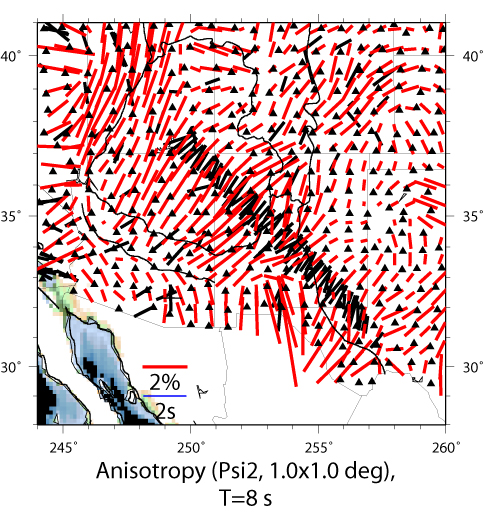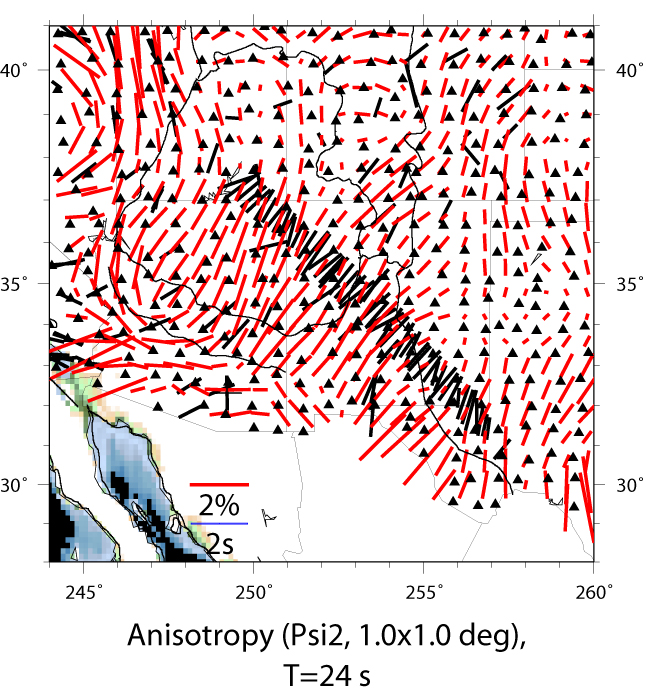Seismic Anisotropy of the Rio Grande Rift
SKS Splitting Beneath
the Rio Grande Rift (from O. Fox portion of website)

SKS splitting is caused
by an anisotropic upper mantle. Anisotropy in the upper mantle is caused
by the LPO (Lattice Preferred Orientation) of olivine and other ellastically
anisotropic minerals in the upper mantle (orthopyroxene). With strain the
LPO of olivine (a-axis) aligns perpendicular with the maximum compressional
direction ( uniaxial compression), perpendicular to shortening direction
(simple shear), or aligns to flow direction (simple shear) (Gao et al 1997).
Passive rifting is expected
to have a LPO to align with the direction of extension. Active rifting
involves asthenospheric upwelling and any fabric that would develop the
LPO would depend on the convection (Gao et al 1997).
SKS Splitting results show
a fast direction in the north-northeast direction, perpendicular to the
regional stress field and parallel to subparallel to the rift trend. Splits
ranged from 0.9 to 1.5 seconds. The interpretation of the rift-parallel
fast polarization direction is consistent with a rift-parallel flow in
a convection cell within the mantle. The Rio Grande Rift is above a low
velocity upper mantle that has been determined from teleseismic tomography
(Gao et al 1997).
Another possible model involves
the SKS splitting to be from fossil anisotropy from past tectonic disturbances
(Laramide deformation). Though it is unlikely that any anisotropy could
be preserved with high heat flow associated from upwelling asthenosphere.
Tomography suggests that the 9000C isotherm is about 50 km beneath
rift zones (Gao et al 1997).
(Figure from Gao et al 1997)

Average fast directions and delay time estimates of the SKS measurement from La Ristra array and others. Shear wave splitting measurements shown with open symbol are from Sanvol et al. (1992). Shaded regions are under Late Cenozoic extension. The black arrow noted with APM is the Absolute Plate Motion of North America. The change of the fast directions is observed at the extreme outheastern end of the array. Although most of the La Ristra measurements show a similar orientation with APM, the fast directions change to North to South in the Southern Rio Grande Rift. (Figure from Gok et al., 2003).



Rayleigh wave azimuthal anisotropy could be resolved from surface wave tomography. Eikonal tomography developed by Lin et al. (2009) is a strong tool ultilizing the dense TA array to unravel the information of Earth's interior. Azimuthal anisotropy maps for 8, 24, 50s Rayleigh wave are shown above. 8s anisotropy map is most sensitive to the crustal shear. This shear structure is related to the surface tectonic region: the fast orientation is along the North America Plate absolute motion's direction. For 24s anisotropy, it is more sensitive to the deep crust shear direction, and the orientation of the fast speed is along the APM of North America in the RGR region. For 50s anisotropy, it has less correlation with surface tectonic regions or plate motion orientation. (Weisen et al, 2010)
Back to Index







